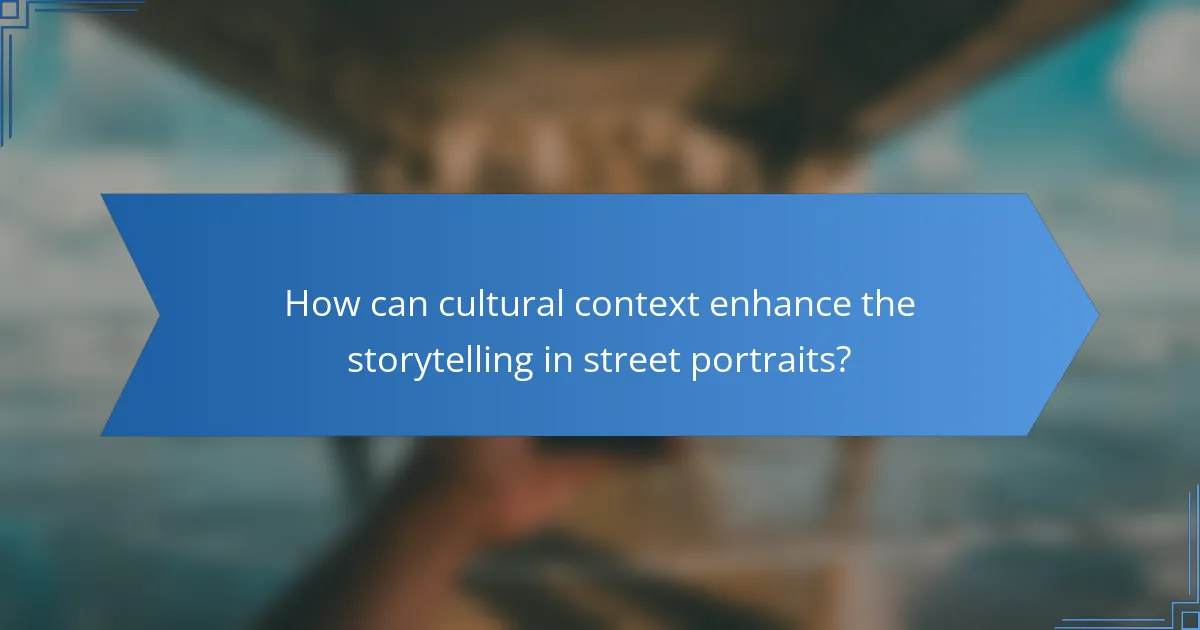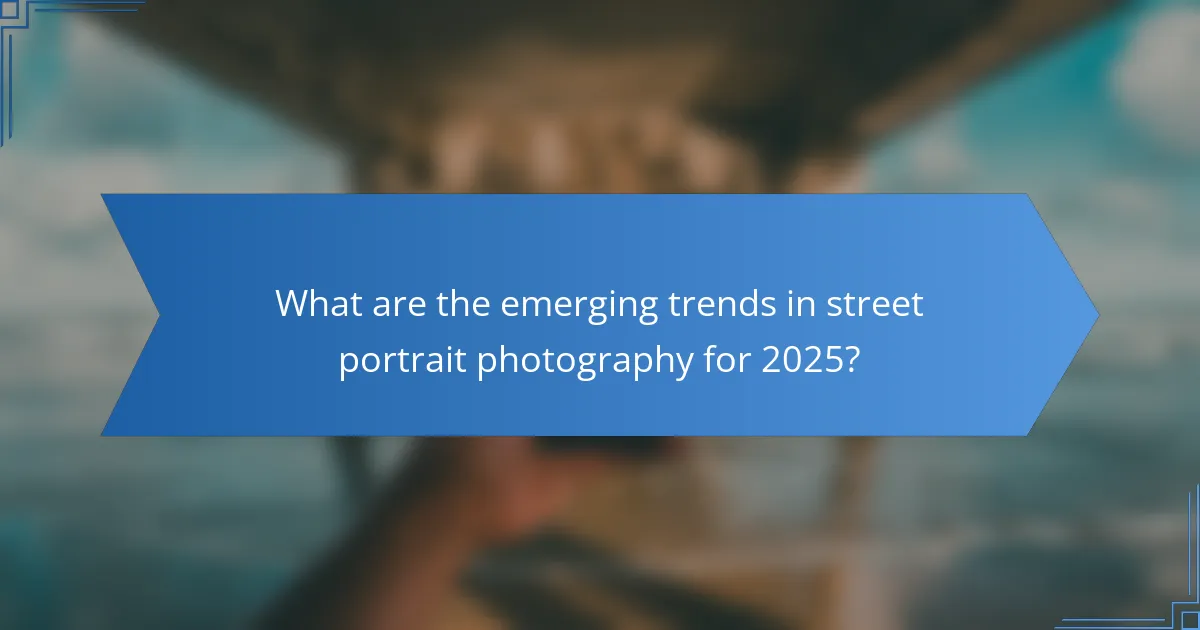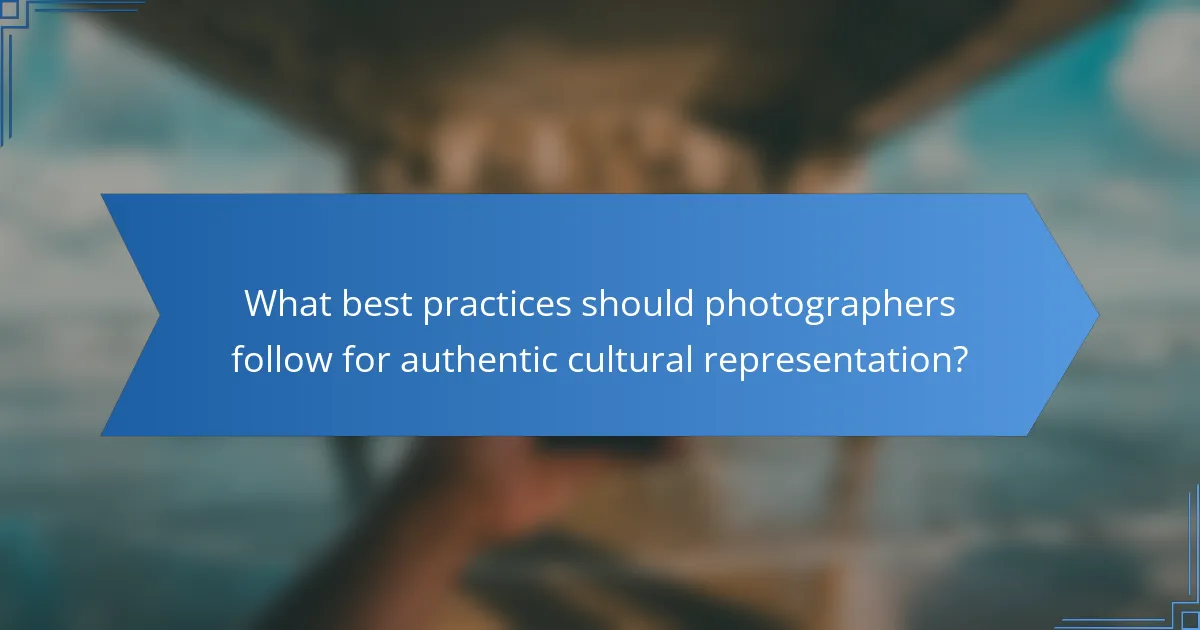Capturing authentic street portraits in urban settings requires building rapport, utilizing natural light, and understanding cultural context. Effective techniques include candid interactions, environmental context, and managing distractions. Emerging trends emphasize collaboration with communities and sustainability, enhancing the authenticity and representation of diverse urban cultures. Prioritizing respect and consent fosters deeper connections and richer narratives in street photography.

What are the key techniques for capturing street portraits in urban environments?
To capture street portraits effectively in urban environments, focus on building rapport, utilizing natural light, and being aware of your surroundings. Engaging with subjects fosters authentic interactions, while natural light enhances image quality. Pay attention to urban elements that add context, such as architecture and street life. Experiment with different angles to create dynamic compositions that reflect the culture and vibrancy of the city.
How does lighting influence the authenticity of street portraits?
Lighting significantly enhances the authenticity of street portraits by shaping mood and context. Natural light, for example, adds warmth and realism, while harsh artificial light can create stark contrasts that may distort the subject’s features. The time of day also plays a crucial role; golden hour light softens shadows and highlights, providing a flattering and genuine representation. Moreover, the environment’s lighting can reflect cultural nuances, enriching the portrait’s narrative. Understanding and manipulating these lighting conditions allows photographers to capture more authentic and engaging street portraits.
What role does composition play in effective street portrait photography?
Composition is crucial in street portrait photography as it directs focus and conveys emotion. Effective framing can highlight cultural elements, enhancing authenticity. Using techniques like rule of thirds or leading lines guides viewer attention, showcasing the subject’s environment. This balance between subject and background creates a narrative, enriching cultural representation.
Which camera settings are essential for street portrait photography?
Essential camera settings for street portrait photography include a wide aperture, fast shutter speed, and appropriate ISO. A wide aperture (e.g., f/1.8) creates a shallow depth of field, isolating the subject. A fast shutter speed (e.g., 1/250s) freezes motion in dynamic urban environments. Adjusting ISO (e.g., 100-800) ensures proper exposure in varying light conditions. These settings enhance the authenticity and cultural representation of subjects in urban settings.

How can cultural context enhance the storytelling in street portraits?
Cultural context enhances storytelling in street portraits by providing depth and authenticity. It allows photographers to capture not just faces but the narratives behind them, reflecting the subjects’ backgrounds, traditions, and emotions. This connection fosters empathy and understanding, making the portraits resonate more deeply with viewers. Additionally, incorporating local elements, such as architecture or clothing, enriches the visual story, showcasing the unique characteristics of the urban environment. Ultimately, cultural context transforms a simple image into a powerful narrative that engages and informs.
What are the ethical considerations when photographing individuals in public spaces?
Ethical considerations in photographing individuals in public spaces include obtaining consent, respecting privacy, and being sensitive to cultural contexts. Photographers should prioritize the dignity of their subjects and avoid exploitation. Engaging with individuals before capturing their image fosters trust and authenticity. Additionally, understanding local norms and laws regarding photography is crucial to ensure respectful representation.
How do cultural backgrounds influence the portrayal in street portraits?
Cultural backgrounds significantly shape the portrayal in street portraits by influencing the subject’s expression, attire, and environment. Different cultures convey unique stories through visual elements. For example, traditional clothing can symbolize heritage, while specific facial expressions may reflect cultural norms. Photographers must understand these nuances to represent subjects authentically. This sensitivity fosters deeper connections between the viewer and the portrait, enhancing appreciation for diverse cultures. Ultimately, an effective street portrait captures not just the subject but also the cultural context that informs their identity.

What are the common challenges faced in street portrait photography?
Street portrait photography often faces challenges like gaining trust, managing lighting, and dealing with distractions. Building rapport with subjects is crucial for authentic representation. Unpredictable urban environments can hinder ideal lighting conditions, requiring adaptability. Additionally, background distractions can detract from the subject, necessitating careful composition. Understanding cultural sensitivities further enhances the portrayal of diverse communities.
How can photographers overcome language barriers while capturing portraits?
Photographers can overcome language barriers while capturing portraits by using visual communication and body language. Engaging with subjects through gestures and expressions fosters connection. Utilizing translation apps can facilitate conversations, ensuring clarity. Additionally, collaborating with local guides can enhance cultural understanding and authenticity.
What strategies can be employed to build rapport with subjects?
To build rapport with subjects in street portraits, engage in genuine conversation and show interest in their stories. Establishing trust is essential for authentic cultural representation.
Active listening fosters connection, allowing subjects to feel valued. Use open body language and maintain eye contact to create a welcoming atmosphere. Asking for permission before photographing respects their autonomy and enhances comfort.
Sharing a bit about yourself can help break the ice, making subjects more willing to share their experiences. Additionally, demonstrating cultural sensitivity by understanding and respecting local customs enriches the interaction.
Lastly, follow up by sharing the final portraits with subjects, reinforcing the relationship and showing appreciation for their participation.

Which unique styles and approaches can differentiate street portraits?
Unique styles and approaches that differentiate street portraits include candid interactions, cultural storytelling, and environmental context. Candid interactions capture genuine emotions, creating authentic connections. Cultural storytelling emphasizes the subject’s background, showcasing their identity through attire or setting. Environmental context situates the subject within their urban surroundings, enhancing the narrative. These techniques collectively enrich the portrayal of diverse urban cultures.
How does the use of color impact the emotional tone of street portraits?
Color significantly influences the emotional tone of street portraits. Warm colors like red and orange evoke feelings of energy and passion, while cool colors such as blue and green can create a sense of calmness or melancholy. The choice of color can reflect cultural nuances, enhancing authenticity in representation. For instance, vibrant colors may communicate joy in certain cultures, while muted tones might signify introspection. Understanding these emotional cues allows photographers to connect more deeply with their subjects and audience, fostering a genuine cultural exchange.
What are the benefits of incorporating local fashion and cultural elements?
Incorporating local fashion and cultural elements fosters authenticity and enriches street portraits. This approach enhances cultural representation, creating a deeper connection between subjects and their environments. It also promotes community engagement, showcasing diverse narratives and preserving cultural heritage. Authentic portrayals resonate more with audiences, highlighting unique attributes of local fashion and traditions.

What are the emerging trends in street portrait photography for 2025?
Emerging trends in street portrait photography for 2025 emphasize authenticity and cultural representation. Photographers increasingly focus on storytelling through candid moments, showcasing diverse urban experiences.
The integration of technology plays a significant role. Mobile devices with advanced camera capabilities allow for spontaneous shooting, capturing genuine interactions. Additionally, social media platforms influence styles, with an emphasis on vibrant colors and dynamic compositions that resonate with audiences.
Collaboration with local communities is gaining traction. Photographers are engaging subjects in the creative process, fostering trust and deeper connections. This approach enhances the authenticity of the portraits and highlights cultural narratives.
Sustainability is another emerging trend. Photographers are becoming more conscious of their environmental impact, opting for eco-friendly practices in their work. This includes using sustainable materials for prints and promoting local art scenes, which aligns with the growing demand for ethical consumption.
How are social media platforms influencing street portrait styles?
Social media platforms are significantly shaping street portrait styles by promoting diverse cultural expressions and encouraging authenticity. They provide a space for photographers to showcase unique perspectives, leading to a wider acceptance of varied styles and narratives. For example, platforms like Instagram highlight spontaneous street photography, influencing artists to capture candid moments that reflect true urban life. Additionally, user engagement drives trends, with popular styles often emerging from viral content, fostering a collaborative environment among photographers. This dynamic interaction enhances cultural representation, making street portraits more relatable and inclusive.
What new technologies are shaping the future of street portrait photography?
Emerging technologies are revolutionizing street portrait photography by enhancing authenticity and accessibility. Innovations such as smartphone cameras with advanced AI capabilities allow photographers to capture stunning images in dynamic urban environments. Drones offer unique aerial perspectives, providing new angles for street portraits.
Furthermore, augmented reality (AR) applications enable real-time editing and effects, enriching the storytelling aspect of portraits. Social media platforms facilitate immediate sharing and feedback, fostering community engagement and cultural exchange. These technologies collectively enhance the representation of diverse cultures in urban settings, making street portrait photography more vibrant and inclusive.

What best practices should photographers follow for authentic cultural representation?
Photographers should prioritize respect, context, and consent for authentic cultural representation in street portraits. Engaging with subjects enhances trust and leads to deeper stories.
Understanding cultural nuances is essential. Researching backgrounds helps avoid stereotypes and promotes genuine connections. Using local knowledge can inform composition and subject choice.
Always seek permission before capturing images. Consent fosters respect and allows subjects to feel valued. This practice builds positive relationships within communities.
Finally, showcase diversity within cultures. Highlighting various perspectives enriches the narrative and promotes a more accurate representation of urban settings.
How can photographers ensure they respect their subjects’ identities?
Photographers can respect their subjects’ identities by prioritizing consent and cultural sensitivity. Engaging in dialogue with subjects fosters trust and understanding. Researching cultural backgrounds enhances authenticity in representation. Utilizing inclusive practices ensures diverse perspectives are honored. Finally, showcasing subjects in empowering ways reinforces their dignity and individuality.
What common mistakes should be avoided in street portrait photography?
Avoiding common mistakes in street portrait photography enhances authenticity and cultural representation. Key errors include neglecting consent, which can lead to ethical issues. Failing to consider lighting can result in unflattering images. Relying too heavily on posed shots can diminish the spontaneity that characterizes street photography. Ignoring the background can distract from the subject and dilute the cultural context. Over-editing images may strip them of their authenticity, while not engaging with subjects can hinder genuine connection and storytelling.